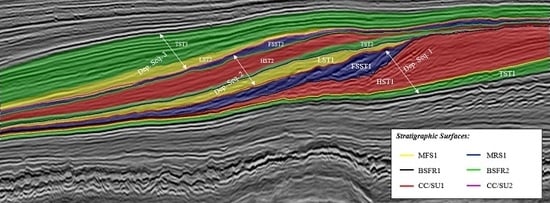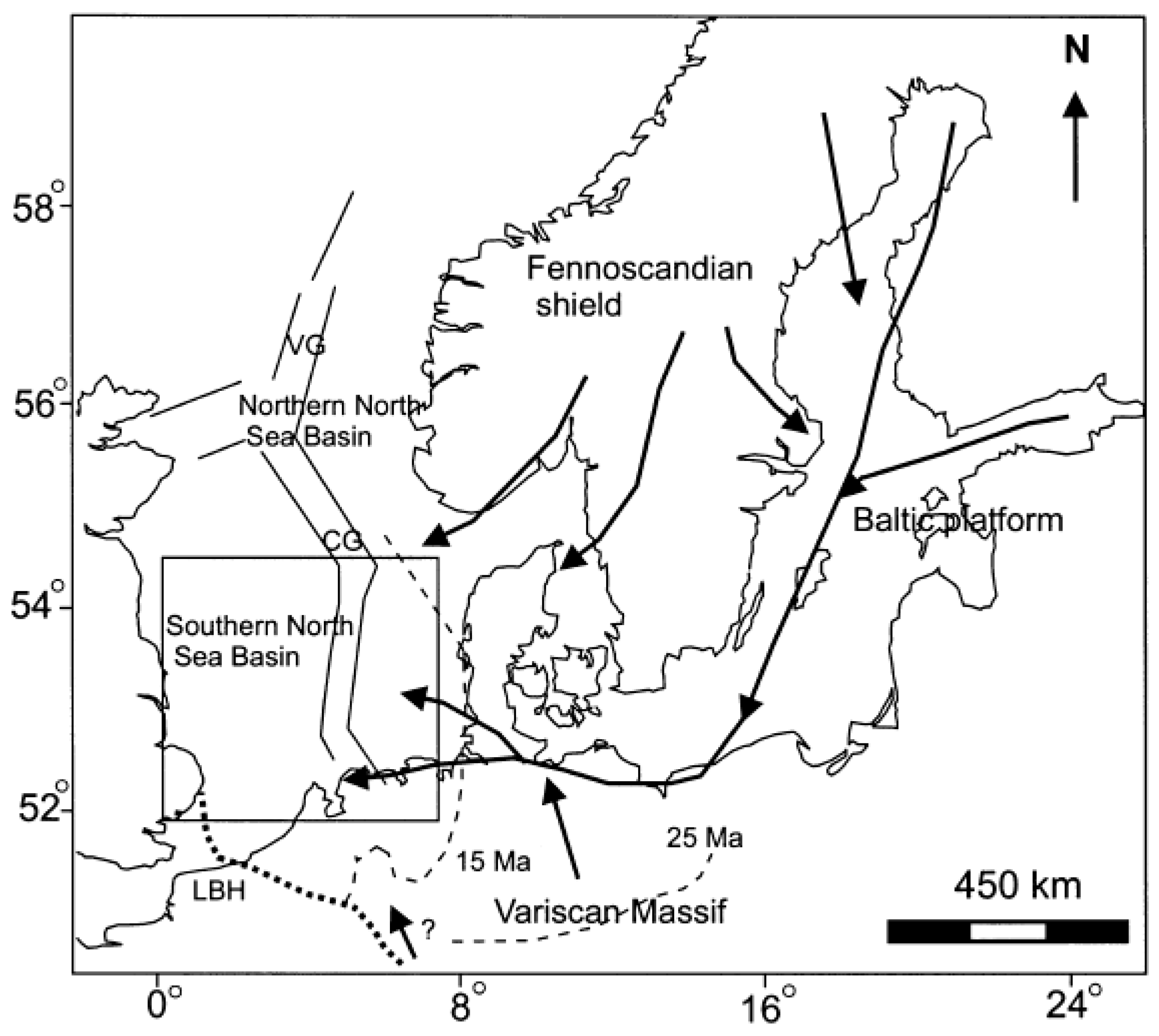The Application of Seismic Attributes and Wheeler Transformations for the Geomorphological Interpretation of Stratigraphic Surfaces: A Case Study of the F3 Block, Dutch Offshore Sector, North Sea
Abstract
:1. Introduction
2. Regional Geological Setting
2.1. Tectonic Framework
2.2. The Stratigraphy of the North Sea Basin
3. Data and Methodology
4. Results and Discussion
4.1. Sequence Stratigraphic Interpretation
4.2. Analysis
4.2.1. Similarity
4.2.2. Dip-Apparent Attributes
MFS1 Surfaces
BSFR1 Surfaces
CC/SU1 Surfaces
MRS1 Surfaces
4.2.3. Maximum Curvature
5. Conclusions
Acknowledgments
Author Contributions
Conflicts of Interest
References
- Adigun, A.; Ayolabi, E. The use of seismic attributes to enhance structural interpretation of z-field, onshore niger delta. J. Climatol. Weather Forecast. 2013. [Google Scholar] [CrossRef]
- Sheriff, R.E. Reservoir Geophysics; Society of Exploration Geophysicists: Tulsa, OK, USA, 1992. [Google Scholar]
- Taner, M.T. Seismic attributes. CSEG Rec. 2001, 26, 48–56. [Google Scholar]
- Strecker, M.R.; Carrapa, B.; Hulley, G.; Scoenbohm, L.; Sobel, E.R. Erosional control of plateau evolution in the central andes. In Proceedings of the 2004 Denver Annual Meeting, Denver, Colorado, 7–10 November 2004. [Google Scholar]
- Koson, S.; Chenrai, P.; Choowong, M. Seismic attributes and their applications in seismic geomorphology. Bull. Earth Sci. Thailand 2014, 6, 1–9. [Google Scholar]
- Catuneanu, O. Principles of Sequence Stratigraphy; Elsevier: Amsterdam, The Netherlands, 2006. [Google Scholar]
- Qayyum, F.; Betzler, C.; Catuneanu, O. The wheeler diagram, flattening theory, and time. Mar. Petrol. Geol. 2017, 86, 1417–1430. [Google Scholar] [CrossRef]
- Qayyum, F.; Betzler, C.; Catuneanu, O. Space-time continuum in seismic stratigraphy: Principles and norms. Interpretation 2017, 6, 1–42. [Google Scholar] [CrossRef]
- Qayyum, F.; De Groot, P.; Hemstra, N.; Catuneanu, O. 4d wheeler diagrams: Concept and applications. Geol. Soc. London Spec. Publ. 2015, 404, 223–232. [Google Scholar] [CrossRef]
- De Bruin, G.; Ligtenberg, H.; Hemstra, N.; Tingdahl, K. Synchronized sequence stratigraphic interpretation in the structural and chrono-stratigraphic (wheeler transformed) domain. In Proceedings of the EAGE Research Workshop 2006, Grenoble, France, 25–27 September 2006. [Google Scholar]
- Qayyum, F.; de Groot, P.; Hemstra, N. Using 3d wheeler diagrams in seismic interpretation—The horizoncube method. First Break 2012, 30, 103–109. [Google Scholar]
- Qayyum, F.; Catuneanu, O.; Groot, P. Historical developments in wheeler diagrams and future directions. Basin Res. 2015, 27, 336–350. [Google Scholar] [CrossRef]
- Mojeddifar, S.; Kamali, G.; Ranjbar, H. Porosity prediction from seismic inversion of a similarity attribute based on a pseudo-forward equation (pfe): A case study from the North Sea basin, Netherlands. Petrol. Sci. 2015, 12, 428–442. [Google Scholar] [CrossRef]
- Jaglan, H.; Qayyum, F.; Hélène, H. Unconventional seismic attributes for fracture characterization. First Break 2015, 33, 101–109. [Google Scholar]
- Odoh, B.I.; Ilechukwu, J.N.; Okoli, N.I. The Use of Seismic Attributes to Enhance Fault Interpretation of OT Field, Niger Delta. Int. J. Geosci. 2014, 5, 826–834. [Google Scholar] [CrossRef]
- Illidge, E.; Camargo, J.; Pinto, J. In Turbidites characterization from seismic stratigraphy analysis: Application to the Netherlands offshore F3 block. In Proceedings of the AAPG/SEG 2016 International Conference & Exhibition, Cancun, Mexico, 6–9 September 2016. [Google Scholar]
- Qayyum, F.; Hemstra, N.; Singh, R. A modern approach to build 3d sequence stratigraphic framework. Oil Gas J. 2013, 111, 46. [Google Scholar]
- Rohrman, M.; Beek, P.; Andriessen, P.; Cloetingh, S. Meso-cenozoic morphotectonic evolution of southern Norway: Neogene domal uplift inferred from apatite fission track thermochronology. Tectonics 1995, 14, 704–718. [Google Scholar] [CrossRef]
- Sales, J. Uplift and subsidence do northwestern Europe: Possible causes and influence on hydrocarbon productivity. Nor. Geol. Tidsskr. 1992, 72, 253–258. [Google Scholar]
- Ghazi, S. Cenozoic uplift in the Stord basin area and its consequences for exploration. Nor. Geol. Tidsskr. 1992, 72, 285–290. [Google Scholar]
- Jordt, H.; Faleide, J.I.; Bjørlykke, K.; Ibrahim, M.T. Cenozoic sequence stratigraphy of the central and northern North Sea basin: Tectonic development, sediment distribution and provenance areas. Mar. Petrol. Geol. 1995, 12, 845–879. [Google Scholar] [CrossRef]
- Riis, F. Dating and measuring of erosion, uplift and subsidence in Norway and the Norwegian shelf in glacial periods. Nor. Geol. Tidsskr. 1992, 72, 325–331. [Google Scholar]
- Riis, F. Quantification of Cenozoic vertical movements of Scandinavia by correlation of morphological surfaces with offshore data. Glob. Planet. Chang. 1996, 12, 331–357. [Google Scholar] [CrossRef]
- Lidmar-Bergström, K.; Ollier, C.; Sulebak, J. Landforms and uplift history of southern Norway. Glob. Planet. Chang. 2000, 24, 211–231. [Google Scholar] [CrossRef]
- Hansen, S. Quantification of net uplift and erosion on the Norwegian shelf south of 66 n from sonic transit times of shale. Nor. Geol. Tidsskr. 1996, 76, 245–252. [Google Scholar]
- Jensen, L.; Schmidt, B. Late tertiary uplift and erosion in the Skagerrak area: Magnitude and consequences. Nor. Geol. Tidsskr. 1992, 72, 275–279. [Google Scholar]
- Rohrman, M.; Andriessen, P.; Beek, P. The relationship between basin and margin thermal evolution assessed by fission track thermochronology: An application to offshore southern Norway. Basin Res. 1996, 8, 45–63. [Google Scholar] [CrossRef]
- Overeem, I.; Weltje, G.J.; Bishop-Kay, C.; Kroonenberg, S. The late Cenozoic Eridanos delta system in the southern North Sea basin: A climate signal in sediment supply? Basin Res. 2001, 13, 293–312. [Google Scholar] [CrossRef]
- Qayyum, F.; Akhter, G.; Ahmad, Z. Logical expressions a basic tool in reservoir characterization. Oil Gas J. 2008, 106, 33–42. [Google Scholar]
- Steeghs, P.; Overeem, I.; Tigrek, S. Seismic volume attribute analysis of the Cenozoic succession in the l08 block (southern North Sea). Glob. Planet. Chang. 2000, 27, 245–262. [Google Scholar] [CrossRef]
- Sørensen, J.C.; Gregersen, U.; Breiner, M.; Michelsen, O. High-frequency sequence stratigraphy of upper Cenozoic deposits in the central and southeastern North Sea areas. Mar. Ptrol. Geol. 1997, 14, 99–123. [Google Scholar] [CrossRef]
- Michelsen, O.; Thomsen, E.; Danielsen, M.; Heilmann-Clausen, C.; Jordt, H.; Laursen, G.V. Cenzoic sequence stratigraphy in the Easter North Sea. In Proceedings of the SEPM 1998 Conference, Sicily, Italy, 4–9 September 1998. [Google Scholar]
- Streif, H. Deutsche Beiträge Zur Quartärforschung in der Südlichen-nordsee; Geologisches Jahrbuch der BGR: Hannover, Germany, 1996. [Google Scholar]
- Tigrek, S. 3d seismic interpretation and attribute analysis of the l08 Block, Southern North Sea Basin. Master’s Thesis, Faculty of Applied Earth Sciences, Delft University of Technology, Delft, The Netherlands, 1998. [Google Scholar]
- Remmelts, G. Fault-related salt tectonics in the southern North Sea, the Netherlands. In AAPG Memoir; AAPG: Tulsa, OK, USA, 1995. [Google Scholar]
- Bijlsma, S. Fluvial sedimentation from the Fennoscandian area into the north-west European basin during the late Cenozoic. Geol. Mijnb. 1981, 60, 337–345. [Google Scholar]
- Vinken, R. The Northwest European Tertiary Basin: results of the International Geological Correlation Programme; Project No. 124; Schweizerbart Science Publishers: Stuttgart, Germany, 1988. [Google Scholar]
- Ziegler, P. Geological Atlas of Western and Central Europe; Geological Society of London: London, UK, 1990. [Google Scholar]
- Cartwright, J. Seismic-stratigraphical analysis of large-scale ridge–trough sedimentary structures in the late Miocene to early Pliocene of the central North Sea. In Sedimentary Facies Analysis: A Tribute to the Research and Teaching of Harold G. Reading; Wiley Online Library: Hoboken, NJ, USA, 1995; pp. 283–303. [Google Scholar]
- Rondeel, H.; Batjes, D.; Nieuwenhuijs, W. Geology of gas and oil under the Netherlands; Kluwer Academic Publishers: Alphen aan den Rijn, The Netherlands, 1996. [Google Scholar]
- Van Adrichem Boogaert, H.; Kouwe, W. Stratigraphic Nomenclature of the Netherlands, Revision and Update by RGD and NOGEPA; Geological Survey of the Netherlands: Haarlem, The Netherlands, 1993. [Google Scholar]
- Qayyum, F.; de Groot, P. Seismic Dips Help Unlock Reservoirs; American Oil and Gas Reporter: Derby, KS, USA, 2012. [Google Scholar]
- Avseth, P.; Mukerji, T.; Mavko, G. Quantitative Seismic Interpretation: Applying Rock Physics Tools to Reduce Interpretation Risk; Cambridge University Press: Hongkong, China, 2010. [Google Scholar]
- De Bruin, G.; Hemstra, N.; Pouwel, A. Stratigraphic surfaces in the depositional and chronostratigraphic (wheeler-transformed) domain. Lead. Edge 2007, 26, 883–886. [Google Scholar] [CrossRef]
- Brouwer, F.; De Bruin, G.; De Groot, P.; Connolly, D. Interpretation of seismic data in the wheeler domain: Integration with well logs, regional geology and analogs. In Proceedings of the 2008 SEG Annual Meeting, Las Vegas, NV, USA, 9–14 November 2008. [Google Scholar]
- De Groot, P.; Huck, A.; de Bruin, G.; Hemstra, N.; Bedford, J. The horizon cube: A step change in seismic interpretation! Lead. Edge 2010, 29, 1048–1055. [Google Scholar] [CrossRef]
- Hunt, D.; Tucker, M.E. Stranded parasequences and the forced regressive wedge systems tract: Deposition during base-level fall—Reply. Sediment. Geol. 1995, 95, 147–160. [Google Scholar] [CrossRef]
- Catuneanu, O. Sequence stratigraphy of clastic systems: Concepts, merits, and pitfalls. J. Afr. Earth Sci. 2002, 35, 1–43. [Google Scholar] [CrossRef]
- Schroot, B.; Schuttenhelm, R. Expressions of shallow gas in the Netherlands North Sea. Neth. J. Geosci. 2003, 82, 91–106. [Google Scholar] [CrossRef]
- Illidge, E.; Camargo, J.; Pinto, J. Turbidites characterization from seismic stratigraphy analysis: Application to the Netherlands offshore F3 Block. In Proceedings of the AAPG/SEG 2015 International Conference & Exhibition, Melbourne, Australia, 13–16 September 2015. [Google Scholar]
- Sigismondi, M.E.; Soldo, J.C. Curvature attributes and seismic interpretation: Case studies from Argentina basins. Lead. Edge 2003, 22, 1122–1126. [Google Scholar] [CrossRef]
- Roberts, A. Curvature attributes and their application to 3 d interpreted horizons. First Break 2001, 19, 85–100. [Google Scholar] [CrossRef]
- Hakami, A.M.; Marfurt, K.J.; Al-Dossary, S. Curvature attribute and seismic interpretation: Case study from Fort Worth Basin, Texas, USA. In SEG Technical Program Expanded Abstracts 2004; Society of Exploration Geophysicists: Littleton, CO, USA, 2004; pp. 544–547. [Google Scholar]
- Chopra, S.; Marfurt, K.J. Seismic curvature attributes for mapping faults/fractures, and other stratigraphic features. CSEG Rec. 2007, 32, 37–41. [Google Scholar]
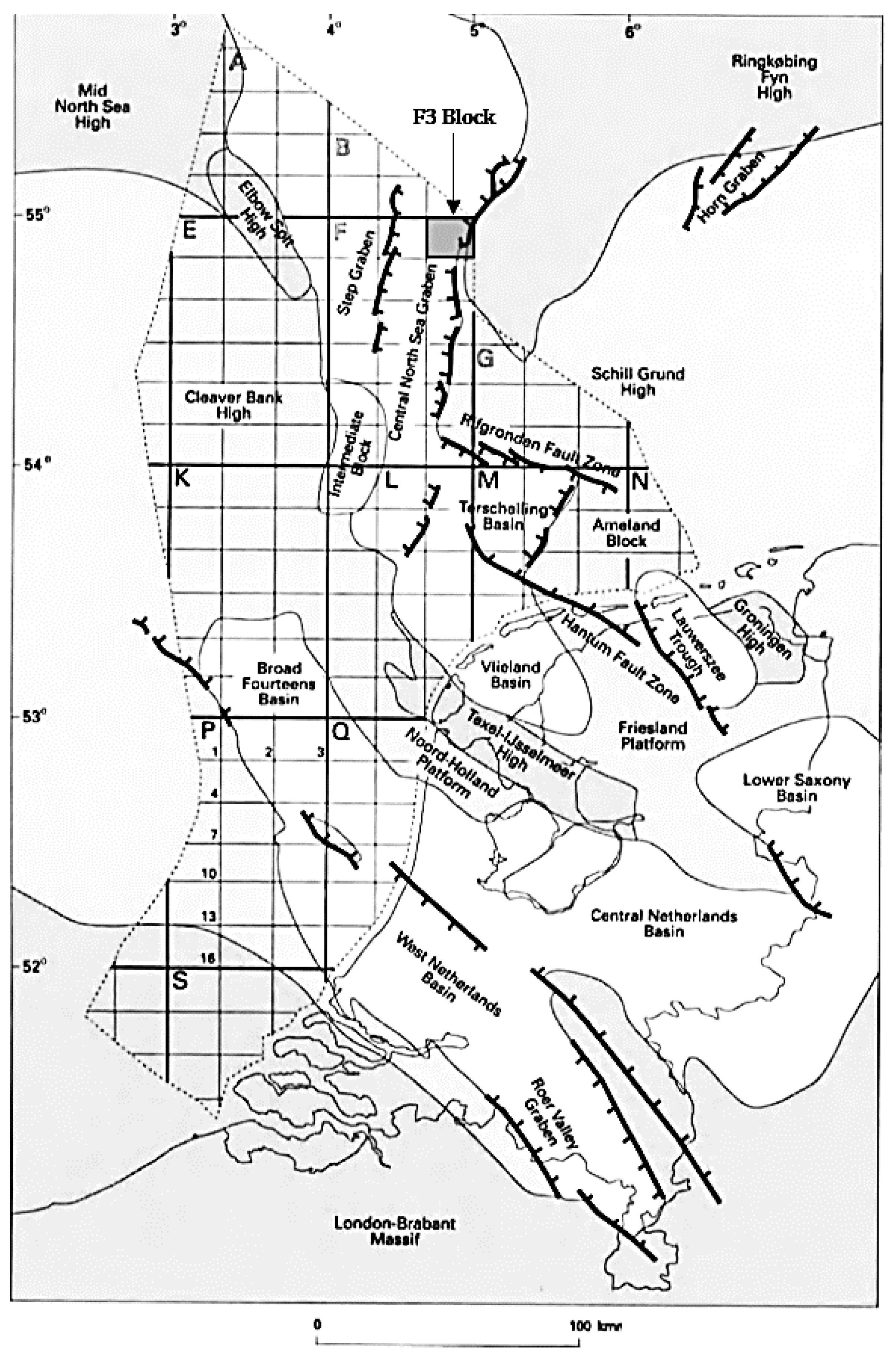
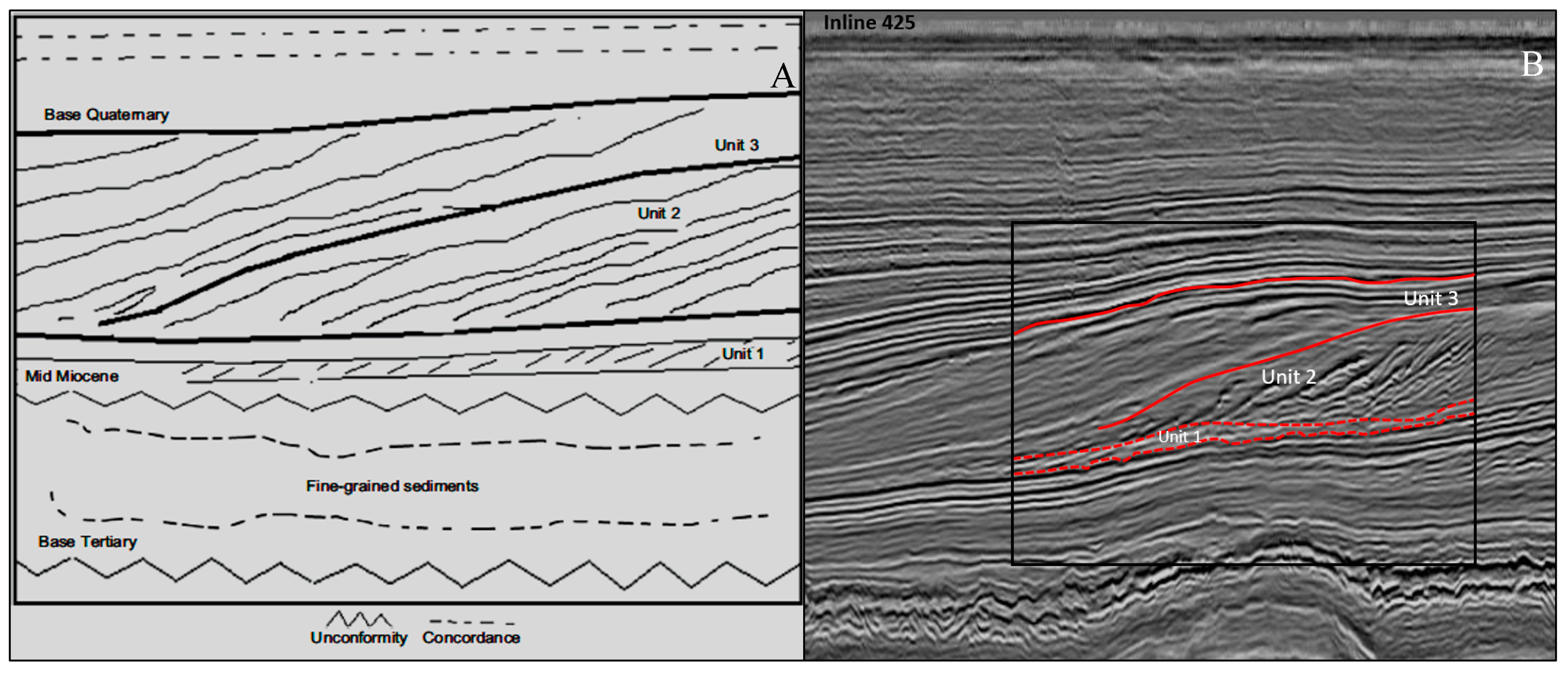
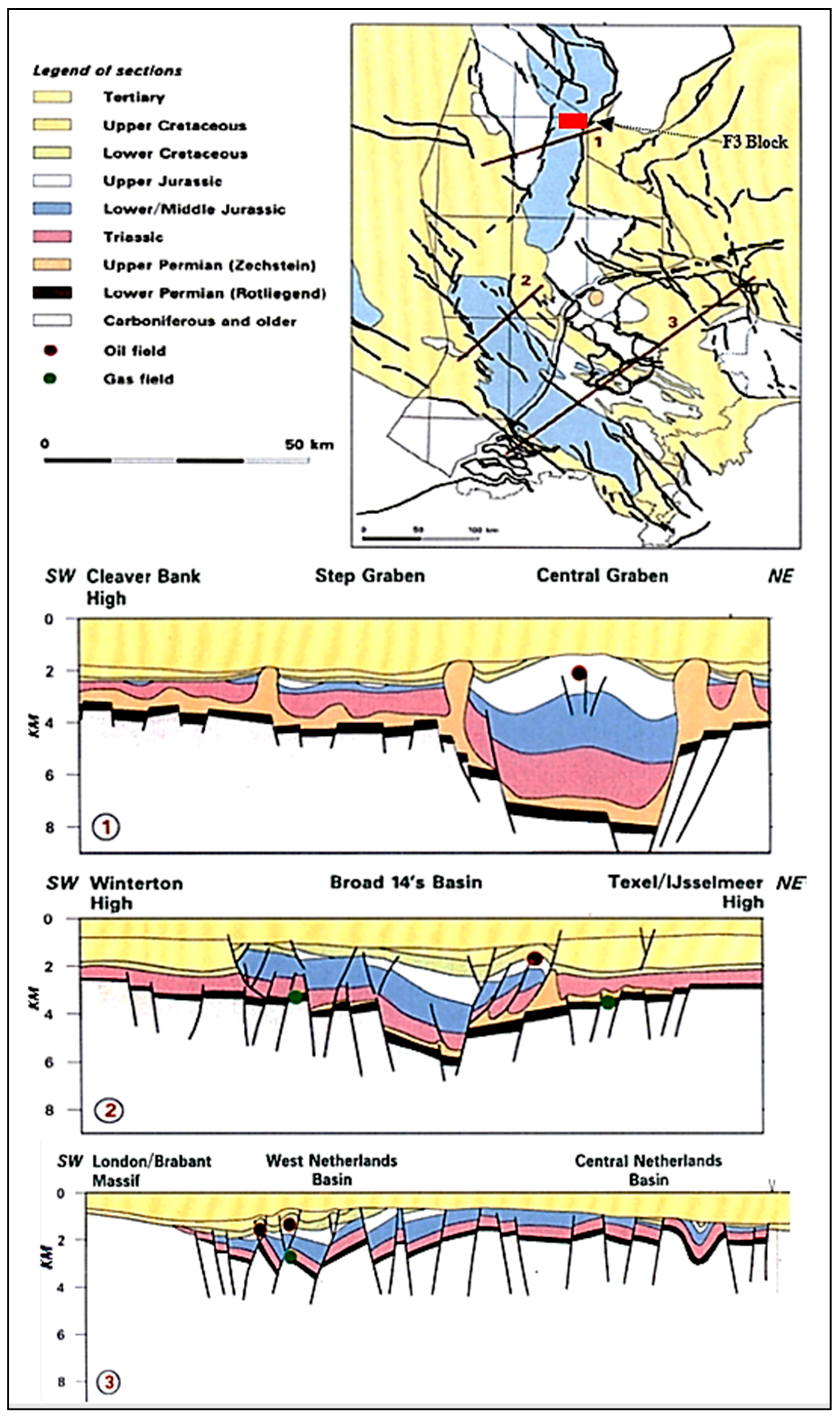
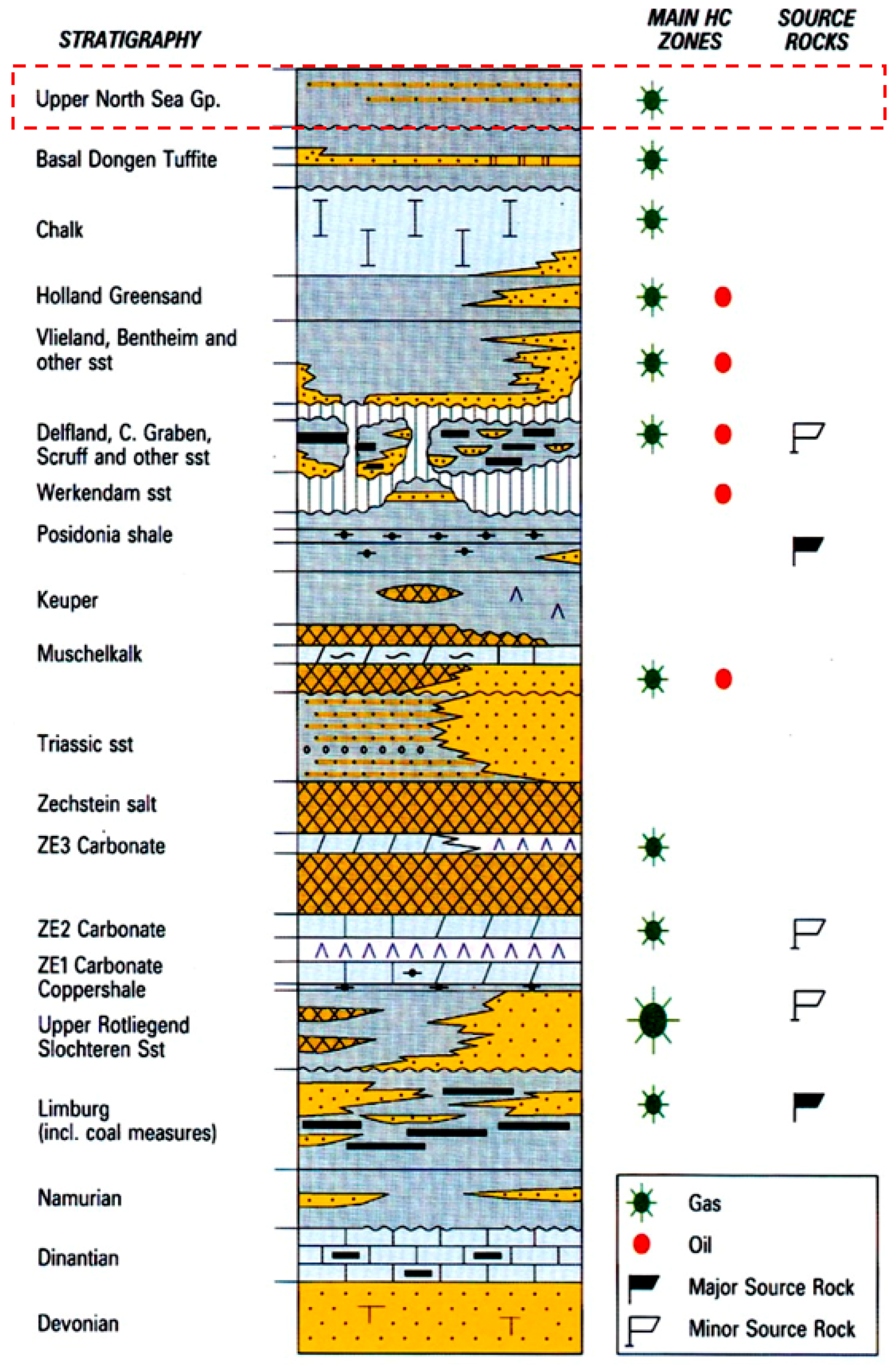
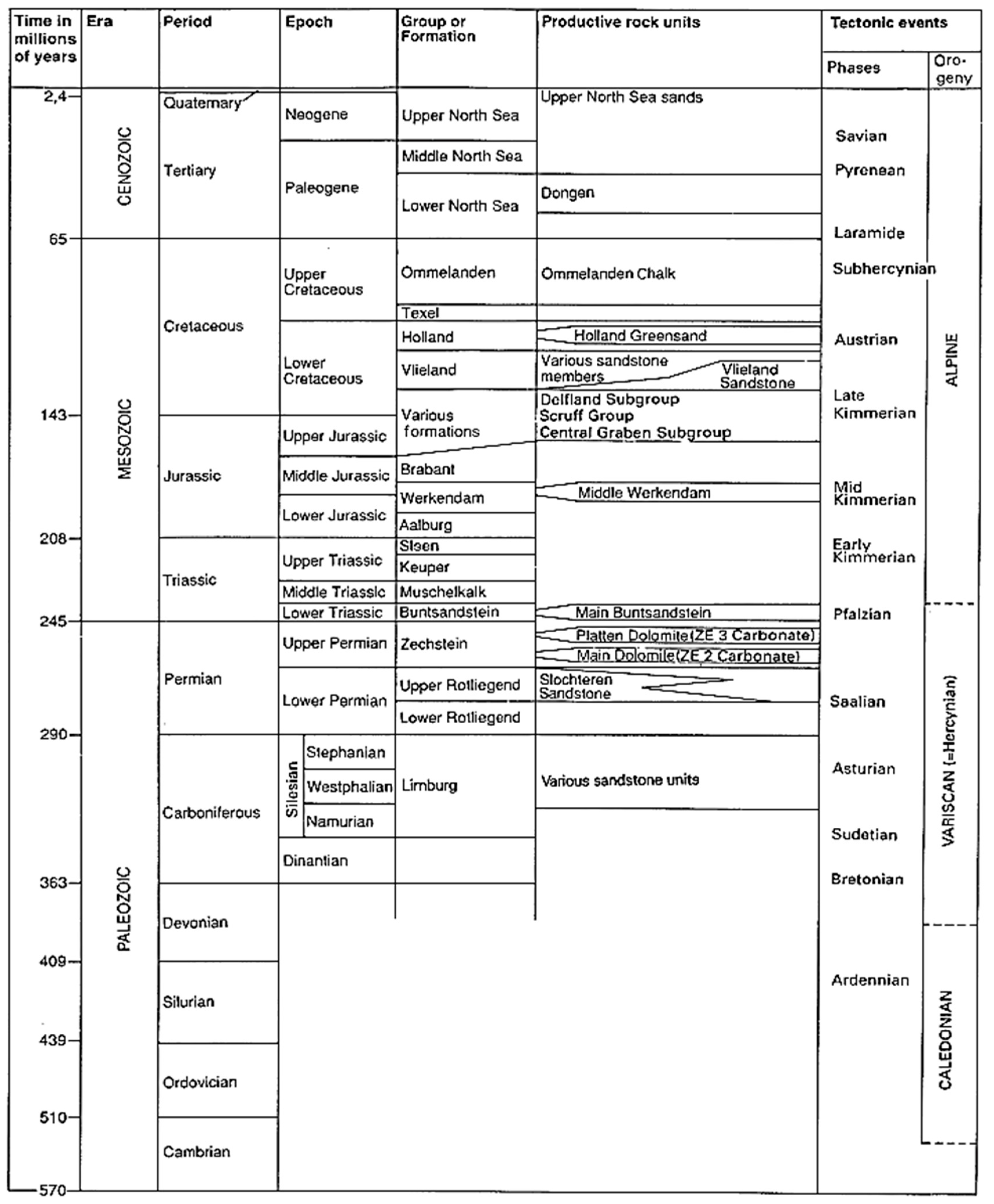
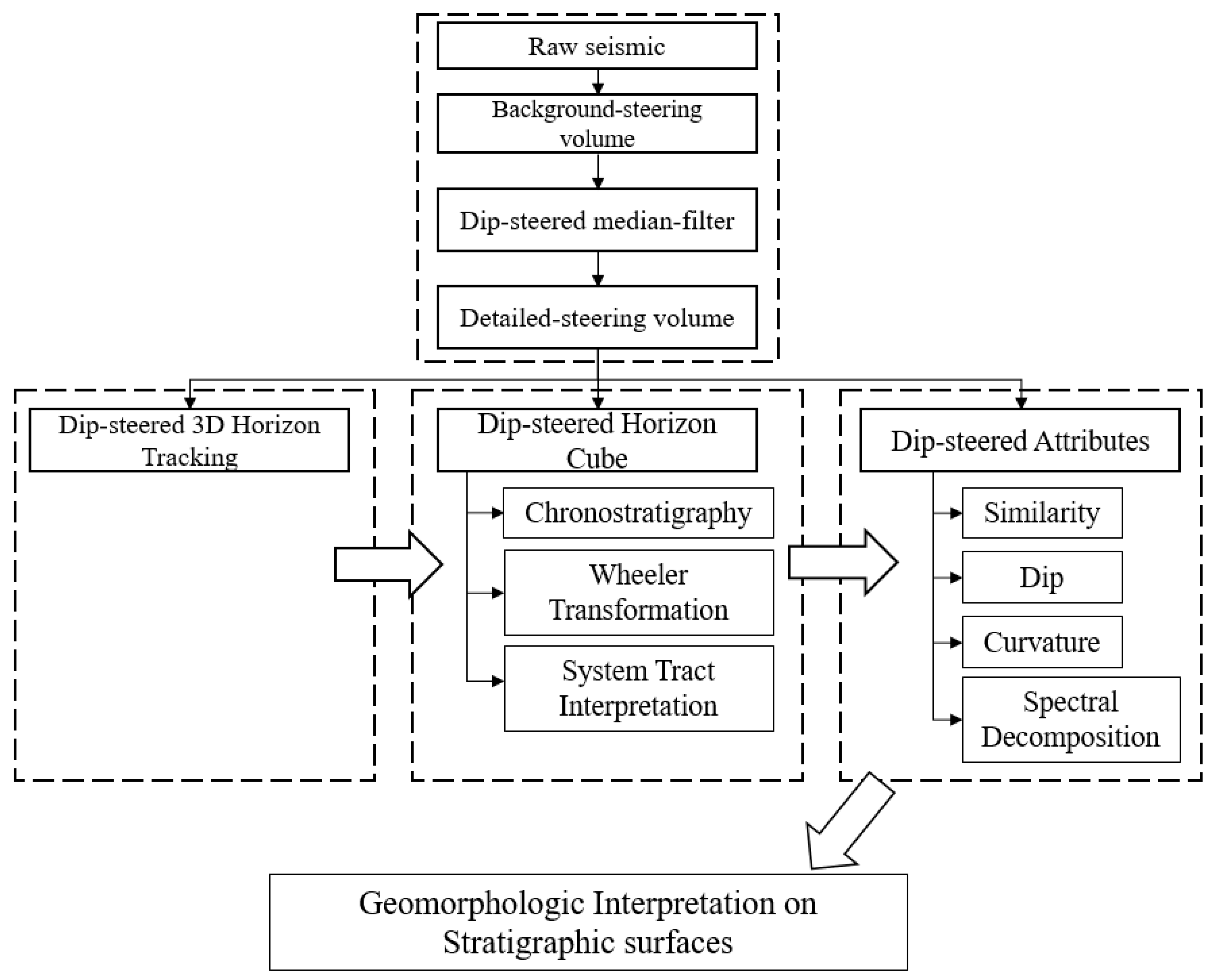
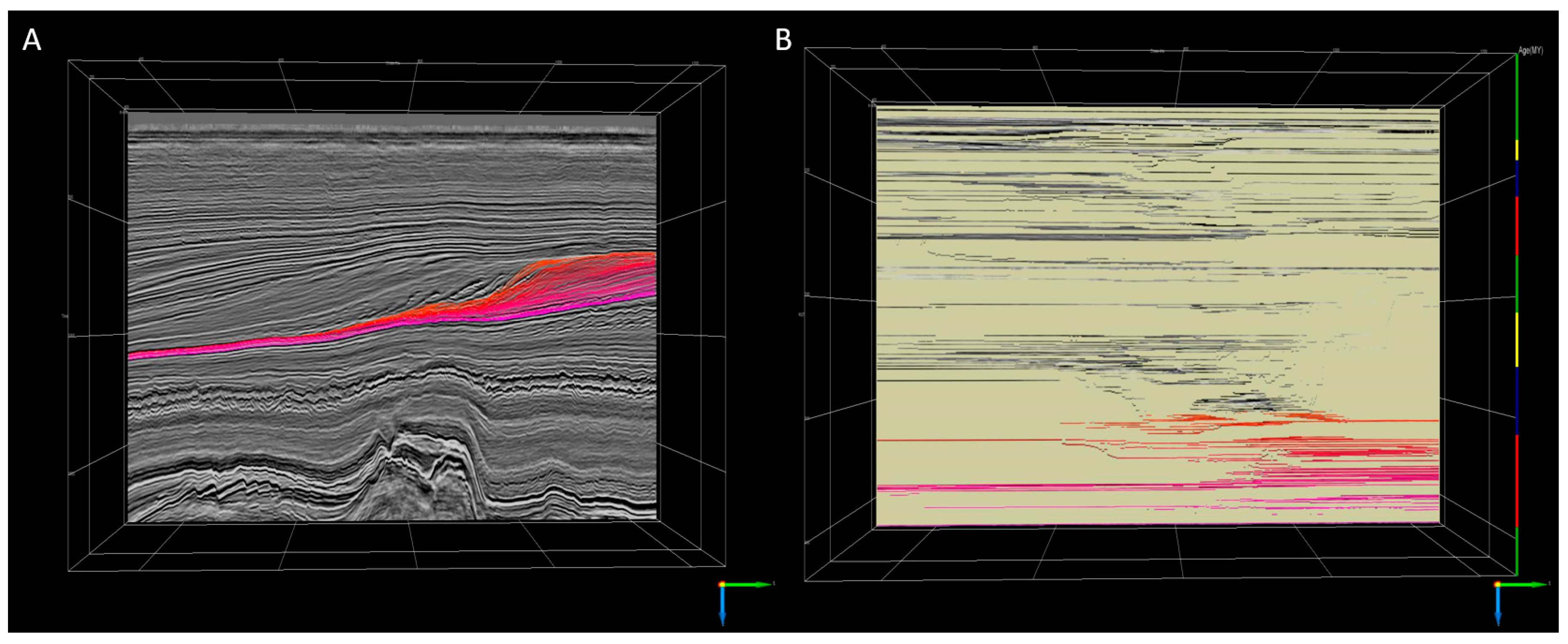
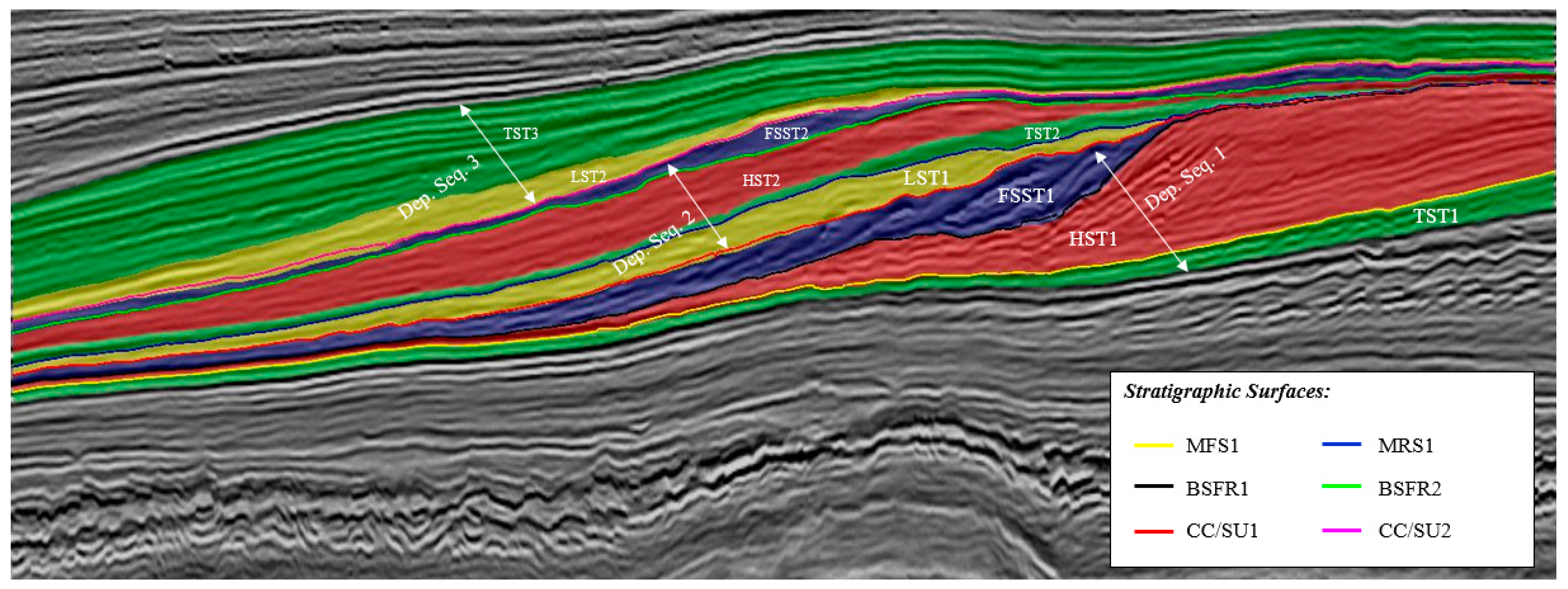
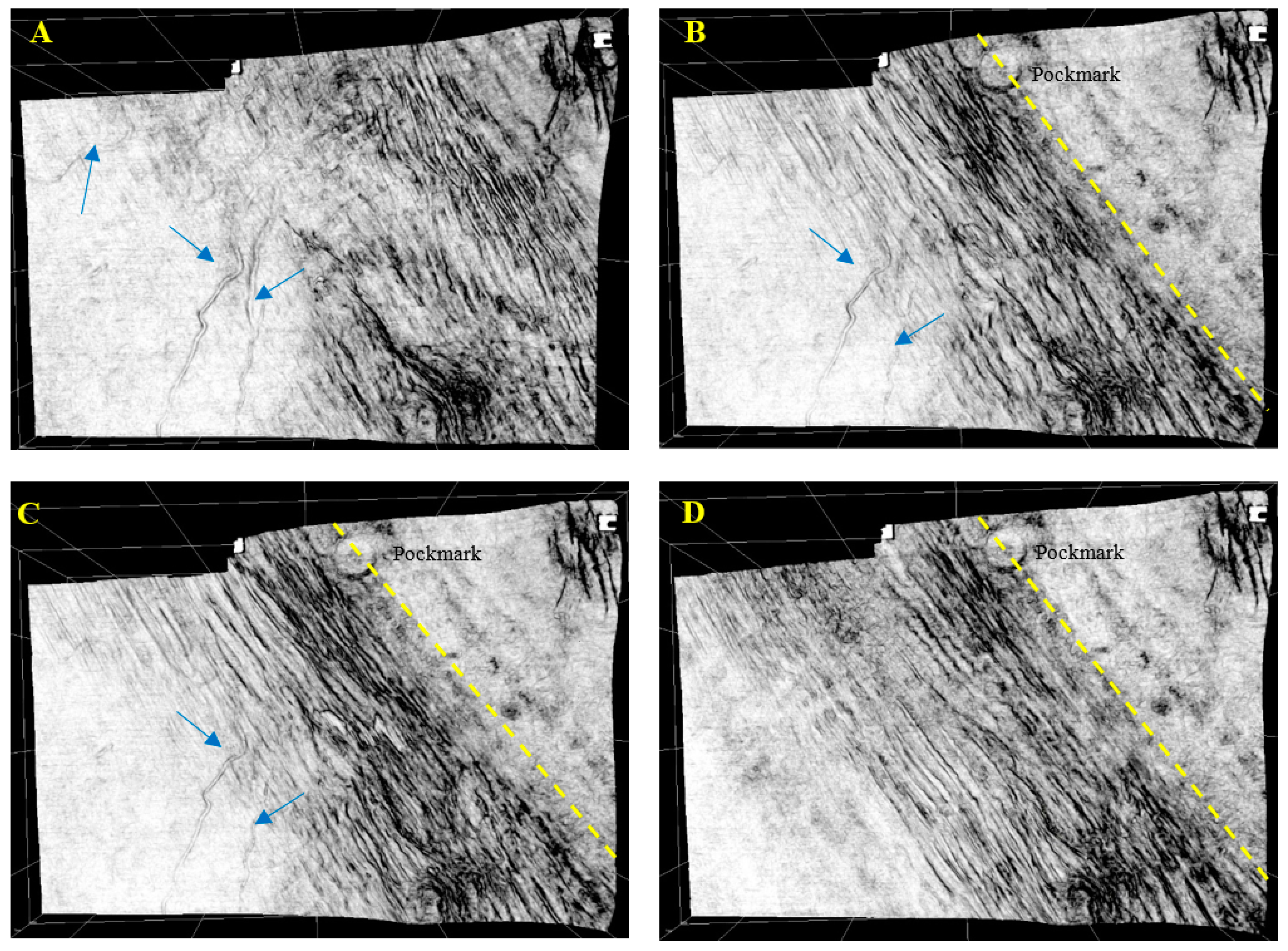
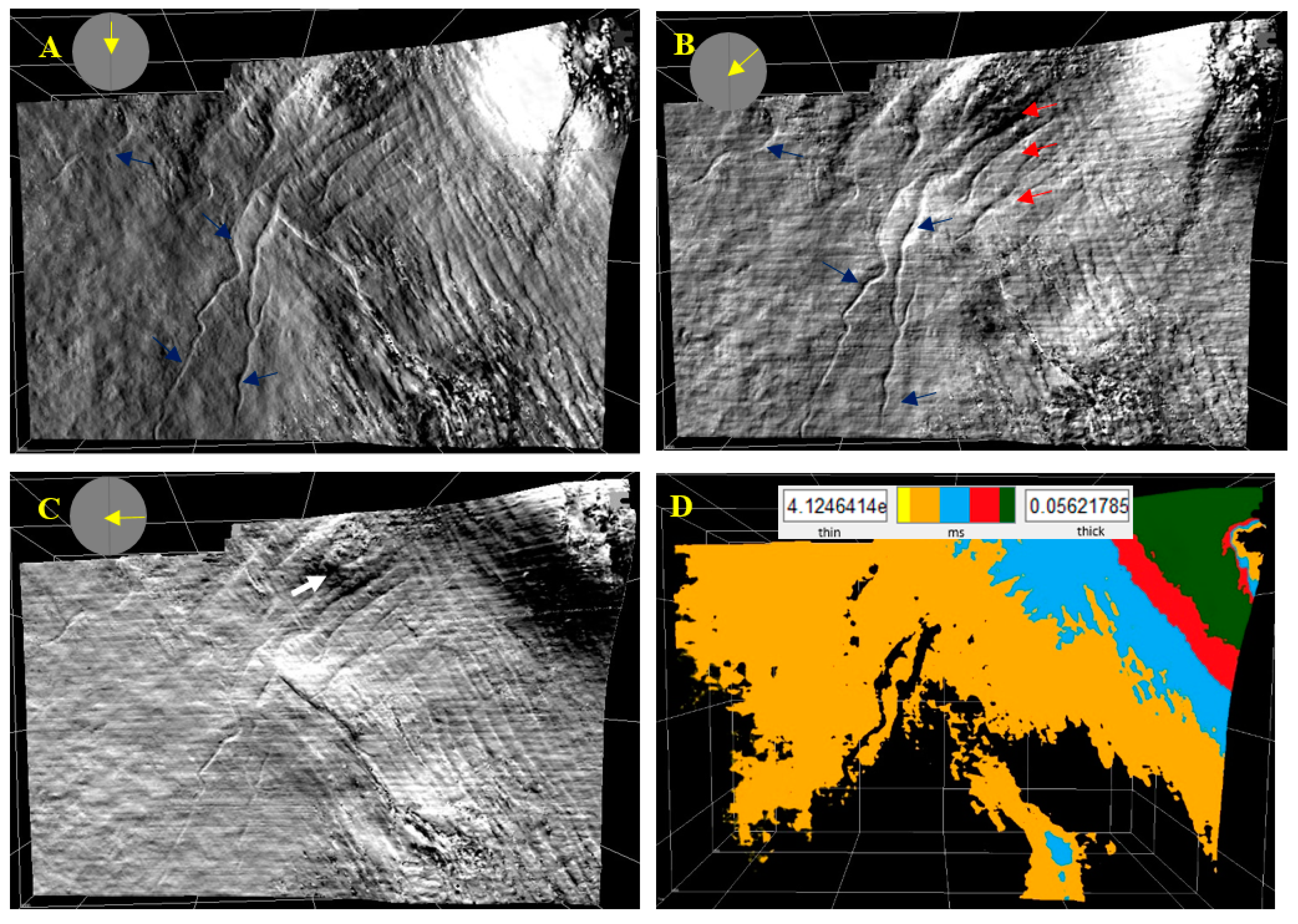
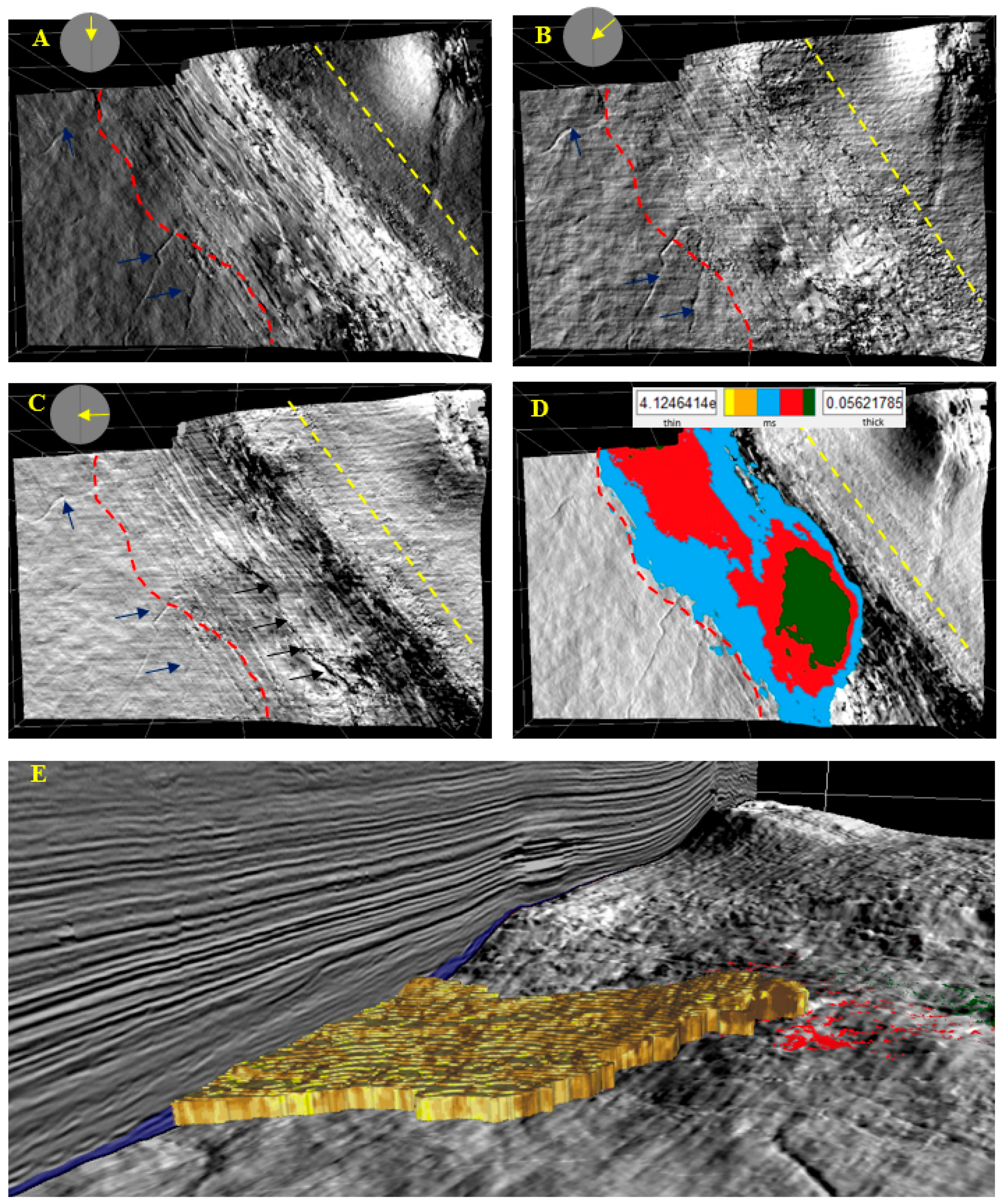
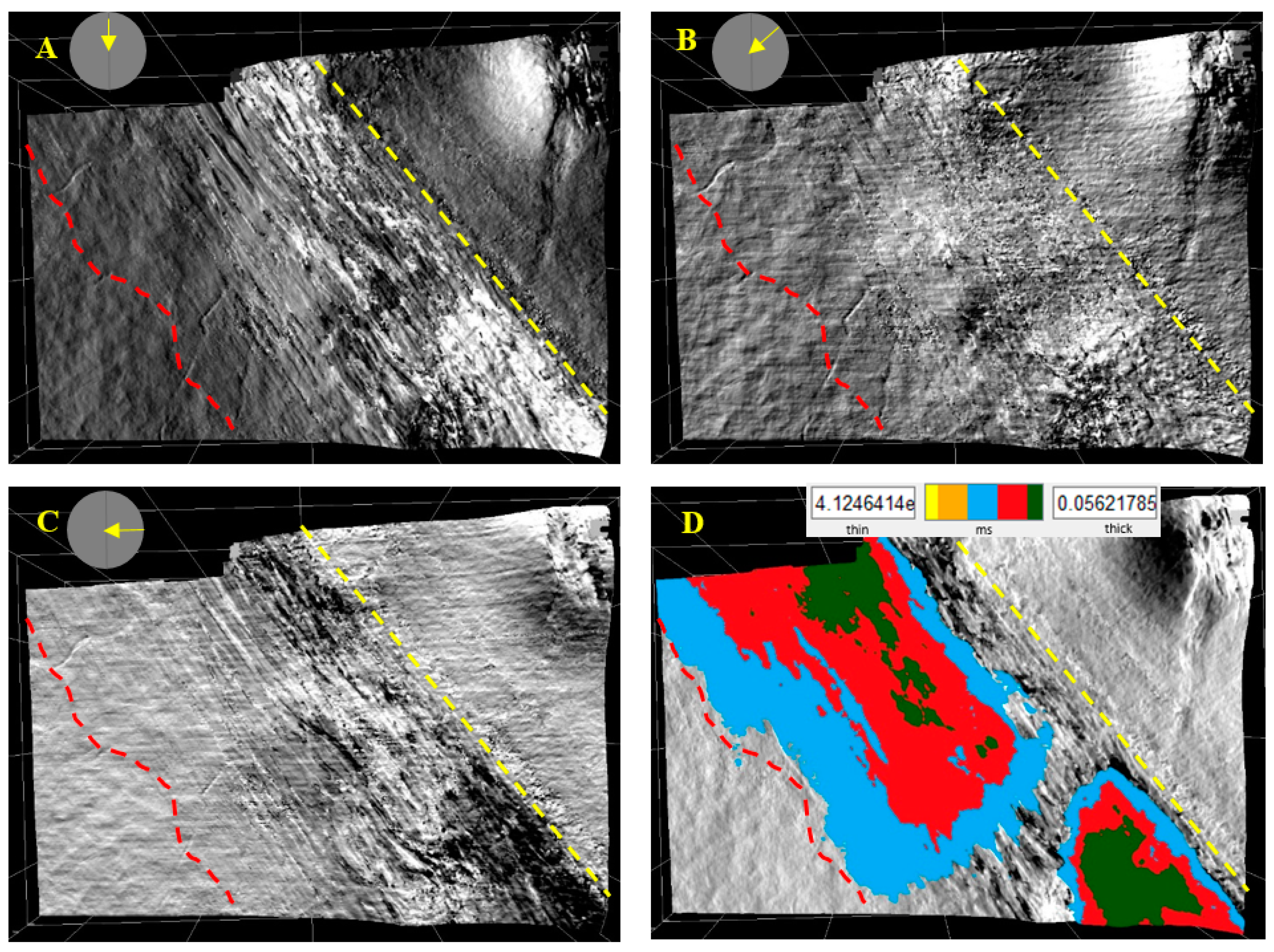
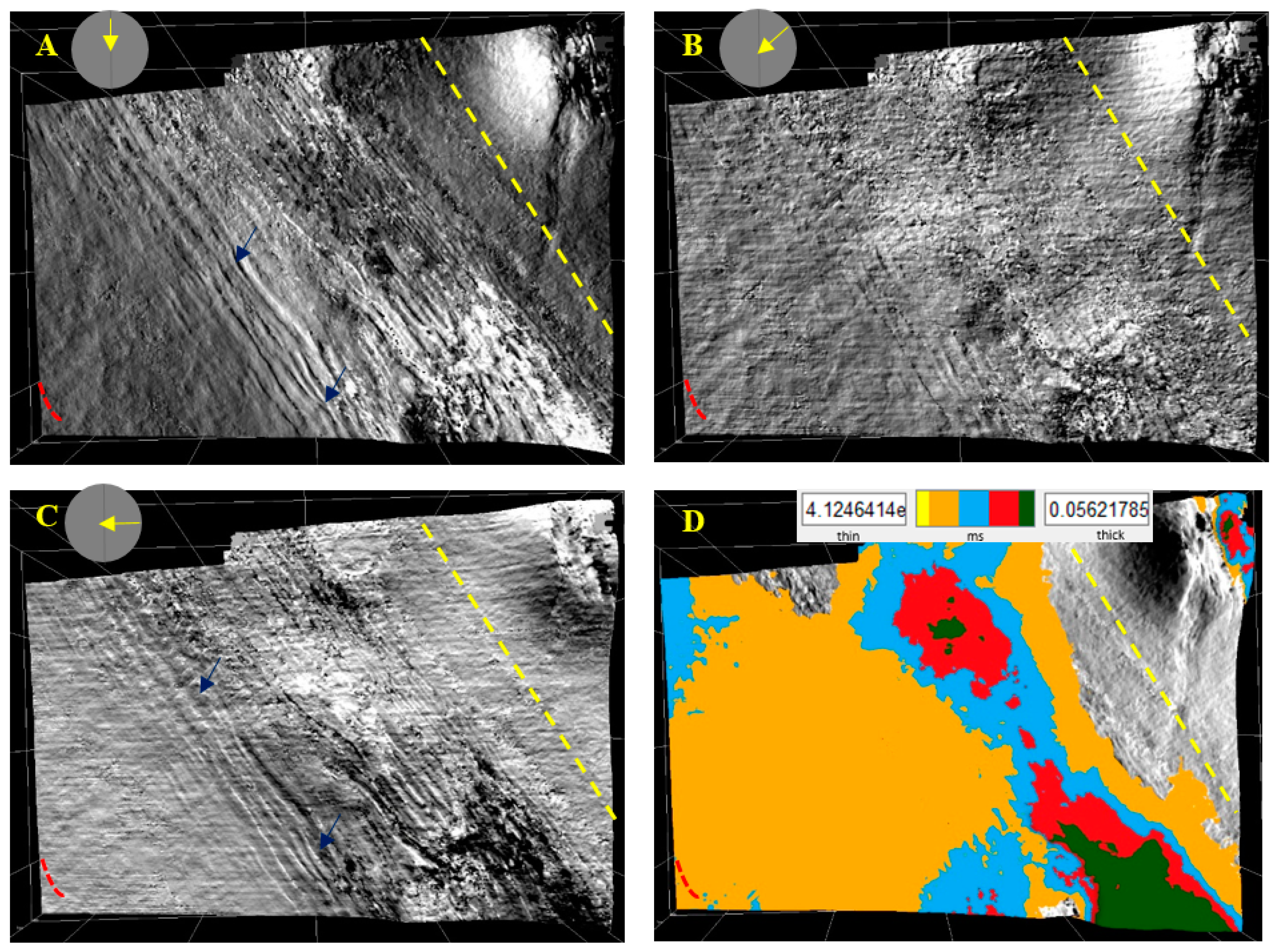

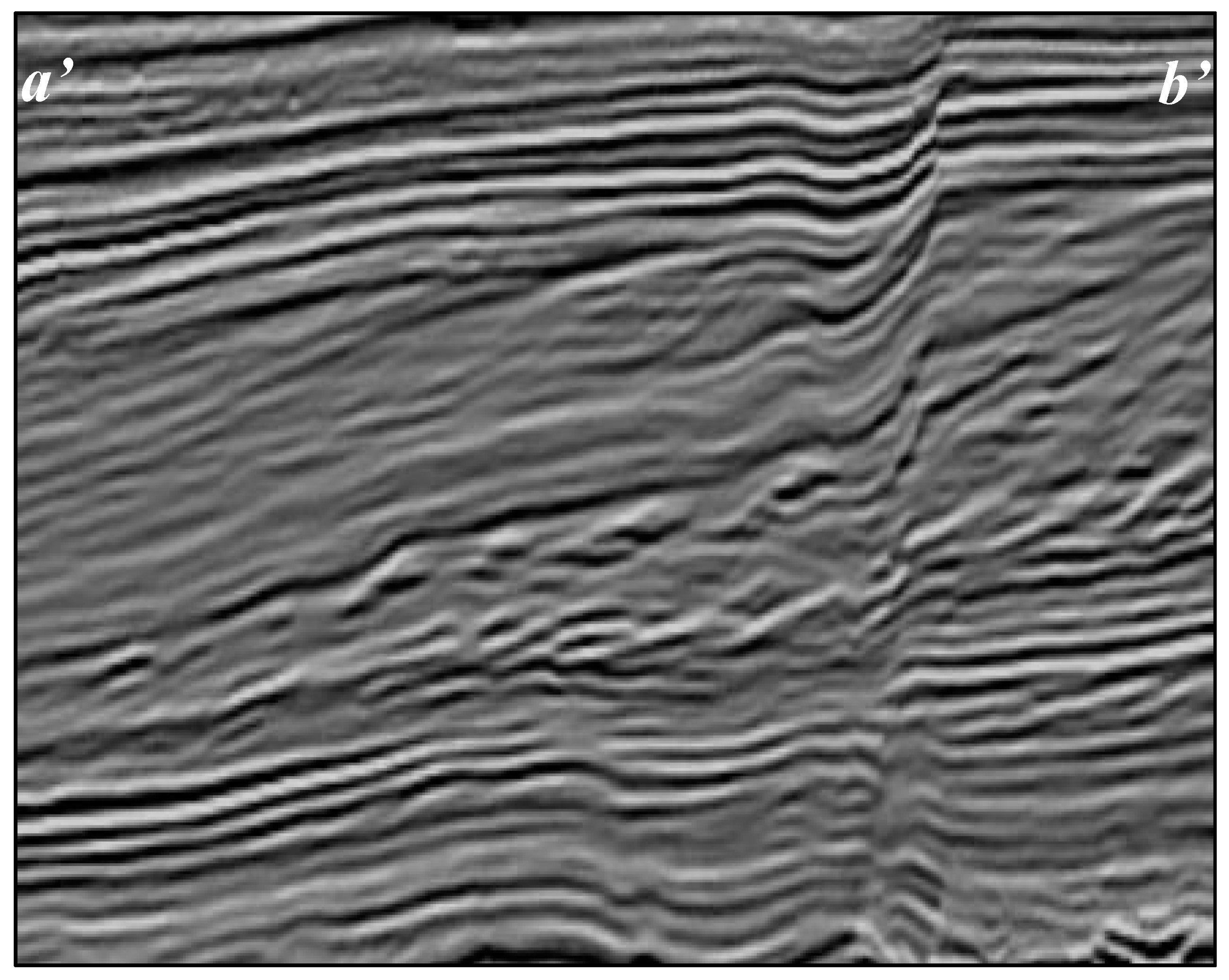
| Attribute | Time Gates (ms) | Step-Out | Dip-Steering | Statistical Operator |
|---|---|---|---|---|
| Raw Steering | - | (1, 1, 1) | - | - |
| Detailed Steering | - | (1, 1, 3) | - | - |
| Background Steering | - | (5, 5, 5) | - | - |
| Similarity | (−8, 24) | (1, 1, 1) | Steered | Minimum Full |
| Curvature | (−28, 28) | (2, 2, 2) | Steered | Maximum |
| Dip | (−28, 28) | (1, 1, 1) | Steered | Apparent |
| No | Stratigraphic Surfaces | Corresponding System Tract Events | Depositional Sequence |
|---|---|---|---|
| 1 | MFS1 | End of TST1 | 1 |
| 2 | BSFR1 | End of HST1 | 1 |
| 3 | CC/SU1 | End of FSST1 | 1 |
| 4 | MRS1 | End of LST1 | 2 |
| 5 | BSFR2 | End of HST2 | 2 |
| 6 | CC/SU2 | End of FSST2 | 2 |
| 7 | MRS2 | End of LST2 | 3 |
© 2018 by the authors. Licensee MDPI, Basel, Switzerland. This article is an open access article distributed under the terms and conditions of the Creative Commons Attribution (CC BY) license (http://creativecommons.org/licenses/by/4.0/).
Share and Cite
Ishak, M.A.; Islam, M.A.; Shalaby, M.R.; Hasan, N. The Application of Seismic Attributes and Wheeler Transformations for the Geomorphological Interpretation of Stratigraphic Surfaces: A Case Study of the F3 Block, Dutch Offshore Sector, North Sea. Geosciences 2018, 8, 79. https://doi.org/10.3390/geosciences8030079
Ishak MA, Islam MA, Shalaby MR, Hasan N. The Application of Seismic Attributes and Wheeler Transformations for the Geomorphological Interpretation of Stratigraphic Surfaces: A Case Study of the F3 Block, Dutch Offshore Sector, North Sea. Geosciences. 2018; 8(3):79. https://doi.org/10.3390/geosciences8030079
Chicago/Turabian StyleIshak, Mohammad Afifi, Md. Aminul Islam, Mohamed Ragab Shalaby, and Nurul Hasan. 2018. "The Application of Seismic Attributes and Wheeler Transformations for the Geomorphological Interpretation of Stratigraphic Surfaces: A Case Study of the F3 Block, Dutch Offshore Sector, North Sea" Geosciences 8, no. 3: 79. https://doi.org/10.3390/geosciences8030079



